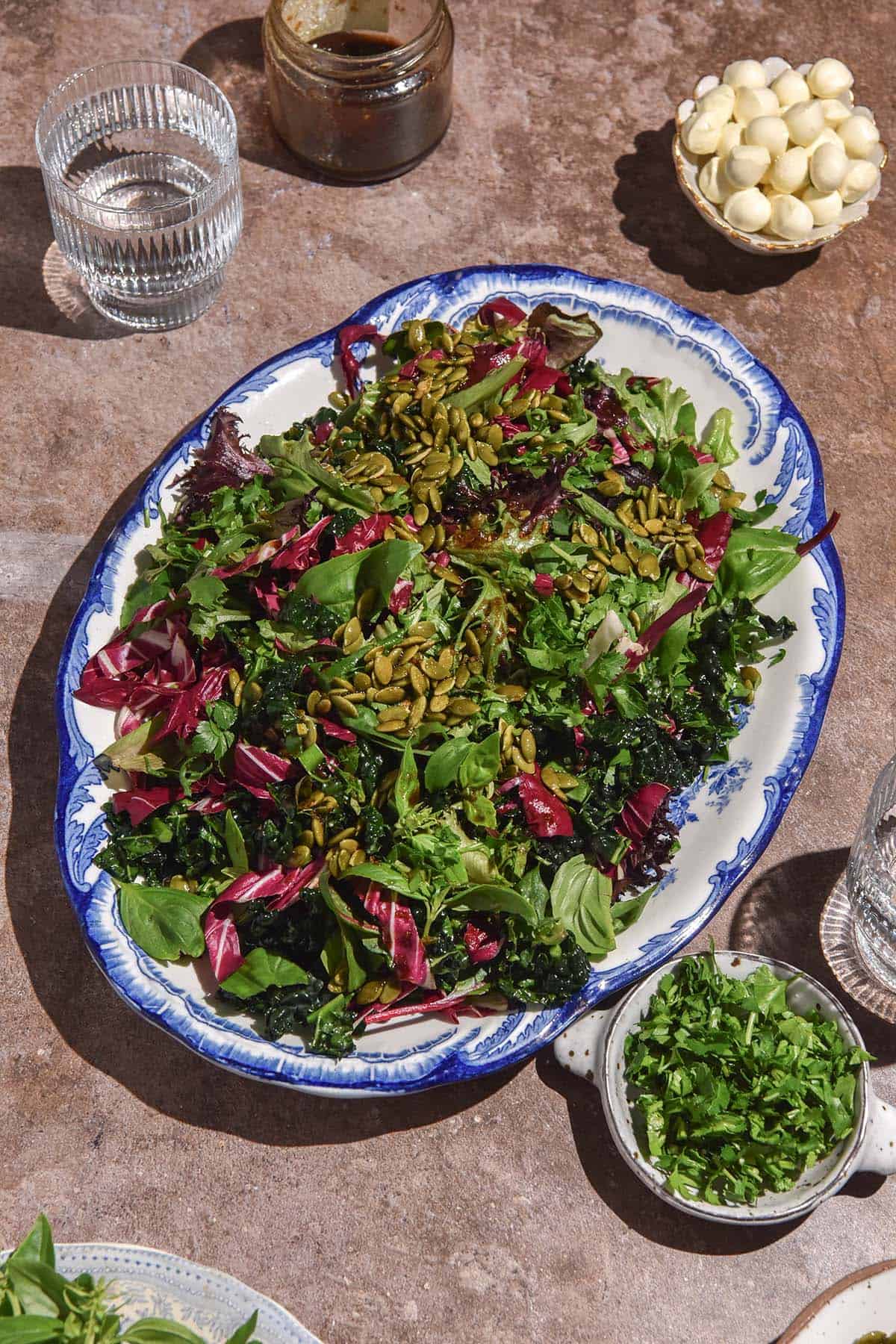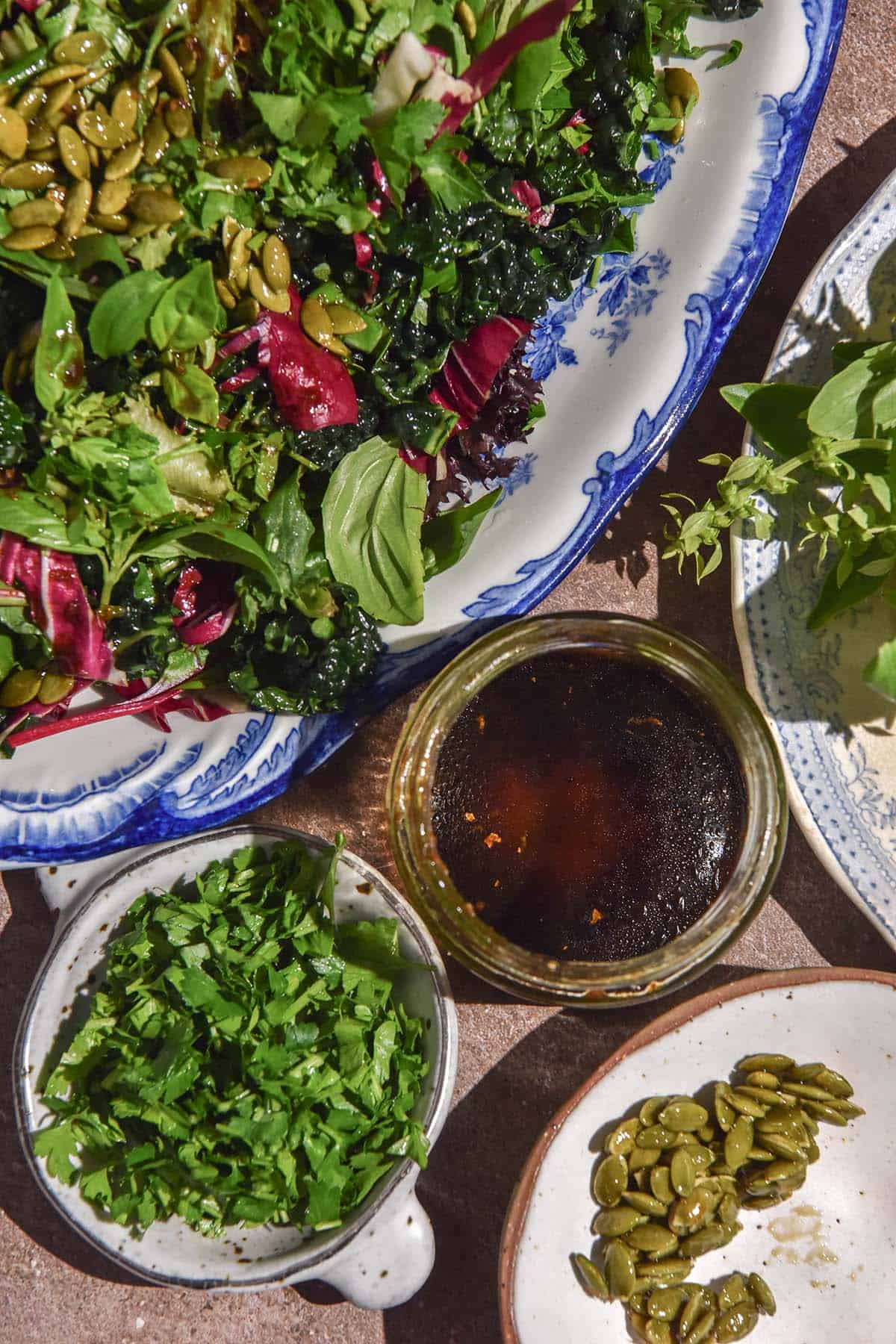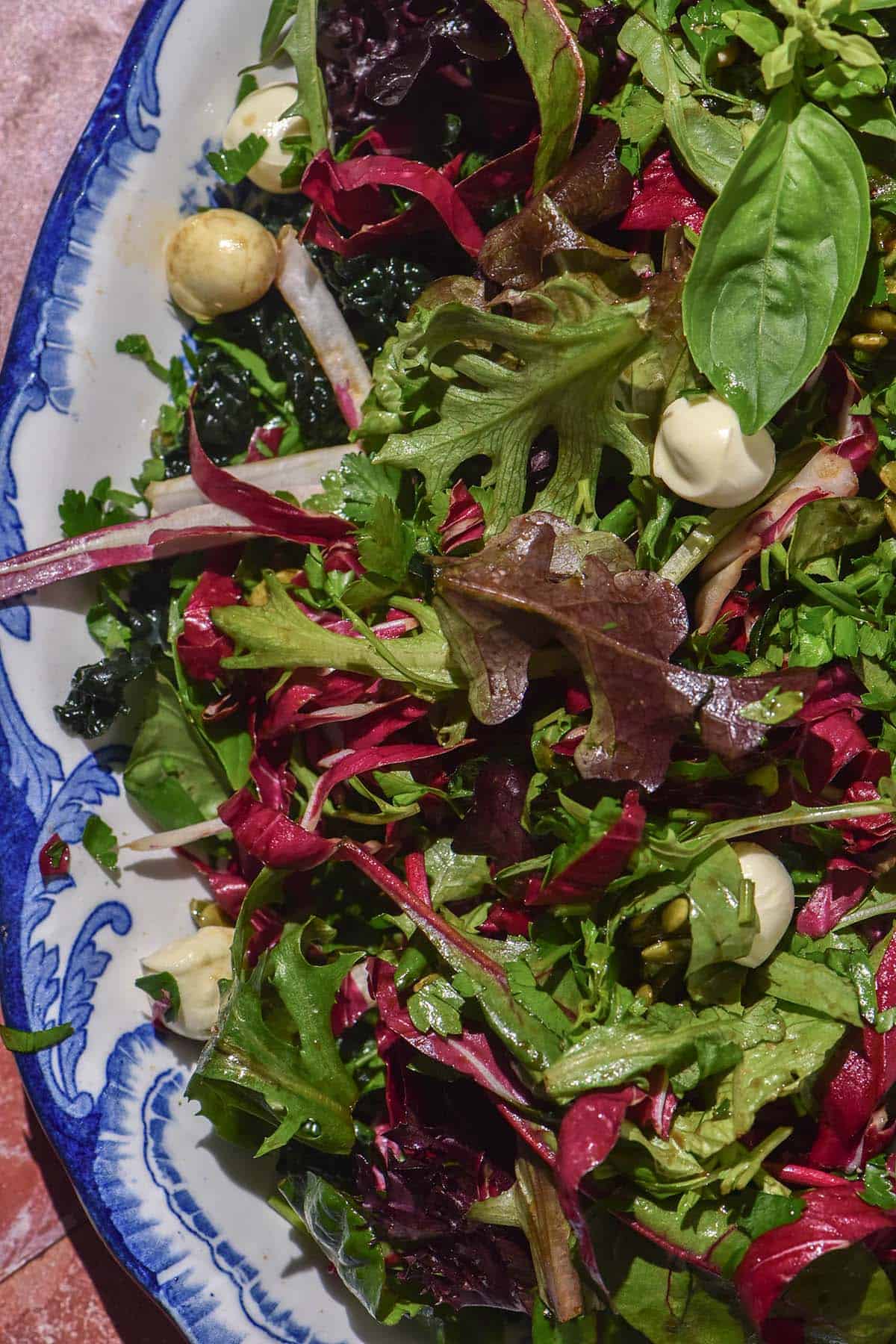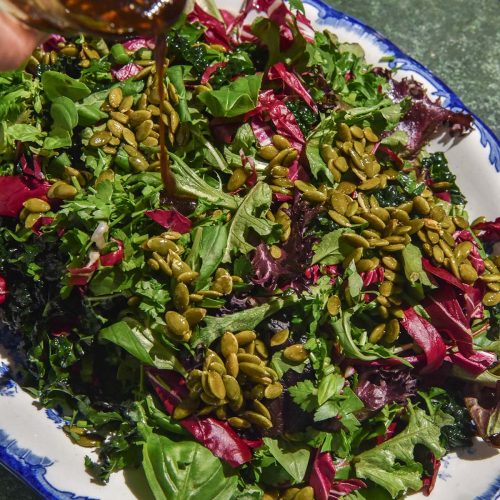
I have been quietly working through the SIBO bi-phasic diet along with a low histamine diet. While the low histamine diet definitely has been working for me, I must say it is a tough diet to do. Many delicious flavour providers can be off the cards, which is why I wanted to develop this easy and delicious low histamine salad dressing recipe.
Low histamine salad dressing recipe
This salad dressing recipe is a simple but delicious one with a few different options. Histamine is a bit of a moving target and not set in stone. What works for me might not work for you. As such, I aim to test lots of different combinations to make sure various things work nicely together.
I use the SIGHI list when developing low histamine recipes and cross-reference with other sources when needed. Some things on the SIGHI list are a little controversial as far as I can tell, but I will note when/if I use one of those ingredients.
This salad dressing is low FODMAP, gluten free, vegan and egg free. I hope to publish more iterations in the future, but I do really love this recipe for flexibility and ease.
A quick note, before we begin: this recipe intends to make life on the low histamine diet a little easier. It is not medical advice and I am not a Doctor. Always see a qualified health professional before embarking on an elimination diet.

Ingredient notes
Some key salad dressing ingredients like black pepper, mustard and a variety of vinegars are not low histamine. So, we have to do a bit of shuffling in order to make a salad dressing that tastes good. Some people report that they tolerate small amounts of these, so it’s up to you to determine whether you are one of those people.
Luckily for us, olive oil and maple syrup or honey are all 0 on the SIGHI list and thus low histamine. So, it’s not all bad news!
Another win is the fact that pomegranate molasses, when made with only pomegranate juice, should be low histamine. Pomegranate molasses itself is low on the SIGHI list, but pomegranate is a 0. Good pomegranate molasses is made with only pomegranate juice and nothing else. If you can’t find any, I saw this recipe to make your own which looks very promising.
Ginger is not a 0 on the SIGHI list, but it is often recommended on a low histamine diet if you can tolerate it. It is anti-histamine and anti-inflammatory and is SO helpful in adding flavour and a bit of ‘heat.’ I love using it in this dressing, but it is completely optional.
Replacing acidity on a low histamine diet
A good squeeze of lemon is one thing I missed most on a low histamine diet. With that in mind, I set out to find a suitable low histamine replacement. Here are some suggestions – they are not all listed on the SIGHI list, so be sure to test your own tolerance. However, the internet consensus is that they are low histamine.
- Fresh cranberries, juiced (listed as a 0 on the SIGHI list).
- Sumac – not listed on the SIGHI list but quoted as being moderate to low histamine. You will need to experiment to see if it works for you.
- Starfruit (listed as 0 on the SIGHI list).
- Citric acid or malic acid (some sources say you need to check that citric acid isn’t made with citrus).
- Pomegranate juice and molasses (pomegranate juice is a 0 on the SIGHI list). A good quality pomegranate molasses should only contain pomegranate juice, so read the label or make your own.
- Some berries, like blueberries and blackberries (although it’s a bit hit and miss as to how much acidity they will contribute) are listed as 0 on the SIGHI list.
- Distilled white vinegar, which is supposedly different to the variety sold in supermarkets (although I haven’t found a whole heap of info on this).
- Sorrel leaves (you could experiment with blending them into a dressing, or else they just add a nice sour note to a salad or dish).
- Rocket/arugula and/or radicchio are bitter favourites that aren’t on the SIGHI list but are thought to be low histamine.

Low histamine flavourings for your salad dressing
You have some options when it comes to adding flavour to your salad dressing. We will go into them below.
- Fresh herbs like parsley and basil. Although I prefer to add fresh herbs to the salad itself, they can easily be finely chopped and included in the dressing.
- Dried herbs like oregano and rosemary. I love adding these to a salad dressing to amp up the flavour without much effort.
- If you tolerate pepper (as in peppercorns) add a little bit of cracked pepper. The SIGHI list says that white pepper is generally more tolerated than black pepper. Sources online also suggest that pink peppercorns are a lower histamine choice. Interestingly though, they are related to the cashew family (so obviously don’t add them if you have a nut allergy).
- I love adding freshly grated ginger to add some spice and kick. Ginger is rated as 1 on the SIGHI list and it doesn’t agree with some people. However, it is anti-inflammatory and anti-histamine, so it’s a great inclusion if you tolerate it.
- Salt! Boring, but salt is a flavour lifesaver on the low histamine diet. It brings out the best in your ingredients flavour wise.
- Garlic and onion (for non-low FODMAPpers) are a 1 on the SIGHI list in small amounts.
- Spring onion greens (for low FODMAPpers) are thought to be low histamine. Just a few finely chopped in your salad dressing will really add in some flavour.

Recipe tips for your low histamine salad dressing
- Don’t omit the water! Even if you just add a tablespoon, the water helps emulsify the dressing and bring everything together.
- I highly recommend making this in a small jar. Shaking to combine also helps emulsify.
- Pick and choose from the above lists to add extra flavour to your salad dressing.
- Another thing to consider is to add extra flavour to your salad itself. I love loading them with herbs to distract from the low histamine nature of the dish lol.
- Pomegranate molasses is available at specialty supermarkets in Australia as well as Middle Eastern grocers. I highly recommend acquiring some – it is lovely and sour but a little sweet and viscous. You could honestly dress your salad with some thinned out pomegranate molasses and be done with it!
- I will say that good pomegranate molasses is made with only pomegranate juice, but some store bought ones (including the one I am using, as it turns out) use more ingredients. Check the label and try to buy one without extra additives to keep the histamine content down.
More low histamine recipes
- Low histamine bread recipe (gluten free)
- Low FODMAP Tomato sauce (lower histamine)
- More recipes to come

Low histamine salad dressing
Ingredients
- 20ml (1 tablespoon)* olive oil or another low histamine oil of choice
- 40ml (2 tablespoons)* pomegranate molasses
- 5-20ml (1-4 teaspoons) maple syrup, to your tastes
- Good quality fine salt, to your tastes
- 20ml (1 tablespoon)* water, to emulsify
- Extra seasonings to flavour (I used dried oregano, a grating of fresh ginger and a pinch of vitamin C powder, see notes in the post and below the recipe)
Instructions
- Add all core ingredients and shake to emulsify.
- Add any extra flavourings you'd like according to your preferences (see notes in the body of the post for some suggestions).
- Taste and adjust the dressing as needed and add 20ml (1 tablespoon) extra water if you'd prefer a thinner dressing.
- If you've added flavours like dried oregano, garlic, spring onion greens or ginger, it can help to make the dressing a little ahead of time to allow the flavour to meld.
- Store in the jar with the lid on in the fridge and use within a few days. Shake to re-emulsify any leftovers before use.
Notes
- See the notes in the body of the post regarding SIGHI scores.
- See the notes in the body of the post on adding acidity and flavourings to your dressing.
- Pomegranate molasses is not on the SIGHI list. However, pomegranate and pomegranate molasses is only made from pomegranate juice – no other ingredients. It is simply pomegranate juice that has been reduced down, so you can make your own if you have concerns about store bought. See this recipe here.

No Comments